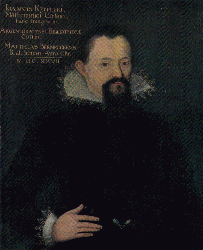




Johannes Kepler (1571-1630). Born on 27 December 1571 in Weil der Stadt, near Stuttgart, in a modest family. He graduated at age 20 from the University of Tuebingen, where he studied mathematics and astronomy under Michael Maestlin (1550-1631), an early supporter of the Copernican system. In 1594, while engaged in the final year of his studies in theology, he was given the chair of mathematics at Graz, where he became increasingly absorbed in astronomy. He was formally expelled from town in 1600 on account of his open adherence to the Protestant faith. He first came to Prague in 1599 to work as an assistant to Tycho Brahe, and upon Tycho's untimely death in 1601 inherited his massive stock of accurate planetary observations, as well as his job as Imperial Mathematician to Rudolf II. In 1612, following the downfall of Rudolf II he moved to Linz, in 1621 to Ulm, and in 1627 to Sagan. On the move again because of religious persecution, he fell ill, and died on 15 November 1630 in Regensburg.
Through a quarter century of painstaking calculations Kepler brought the Copernican system to its modern form by replacing Copernicus circular heliocentric orbits by ellipses, with the Sun at one focus. The process through which he arrived at his justly famous Laws of Planetary Motion was often a contorted one, as Kepler's peculiar mixture of physical insight and mystical inclinations lead him to seek causes for the number and arrangement of planetary orbits, as opposed to constructing purely mathematical descriptions. His first such model involved the nesting of the five regular solids and was published in his 1596 Mysterium Cosmographicum. While never relinquishing this idea, in his 1619 Harmonices Mundi he also sought an explanation in terms of musical harmonies. Hidden deep in this work is the first statement of Kepler's so-called Third Law, establishing the proportionality of the square of planetary orbital periods to the cube of their mean distance to the Sun.
Kepler's first two Laws of Planetary Motion were first adumbrated in his 1609 Astronomia Nova, but first laid out in detail together with his Third Law in book IV of his monumental work Epitoma astronomia Copernicanae, published between 1617 and 1621. The underlying physical explanation of his Laws would have to wait over half a century, until Isaac Newton provided the answer in terms of the theory of universal gravitation.
In 1627 Kepler also finally published what was to be the crowning (but somewhat belated) achievement of Tycho Brahe's career: the Rudolphine Tables of planetary positions. These made full use of Tycho's store of accurate observations in conjunction with Kepler's new model for planetary orbits.
On 28 May 1607 Kepler used his newly devised camera obscura to observe the solar disk and saw sunspot, which he mistook for a transit of Mercury, to the amazement of later astronomers who all agreed that of all people, Kepler really should have known better. Because of Kepler's position as Imperial Mathematician, his prompt and enthusiastic public endorsement of Galileo's telescopic discoveries did a lot to publicize the latter's fame in northern Europe.
Kepler was a prolific author by any standards. Besides his astronomical books, he is (by some) credited with having written the first science fiction novel, his Somnium, published posthumously in 1634 and describing a voyage to the Moon. He wrote extensively on geometrical optics, and was the first to correctly sort out once and for all the production of real versus virtual images by mirrors and lenses. He is also said to have laid the foundations of cristallography in a little book on snowflakes written as a New Years gift to his patron Rudolf II in 1611.
Caspar, M. 1959, Kepler, [1993 Dover reprint].
Beer, A., & Beer, P. (eds.) 1975, Kepler, vistas in astronomy vol. 18, Pergamon Press.
Gingerich, O. 1989, Johannes Kepler, in The General History of Astronomy, vol. 2A, eds. R. Taton and C. Wilson, Cambridge University Press, pps. 54-78.
 To search for a Solar Physicist
To search for a Solar Physicist
![]() To references and further reading
To references and further reading
last modification on january 18 2008 by
paulchar@astro.umontreal.ca
Tous droits réservés / Copyrighted by
Université de Montréal